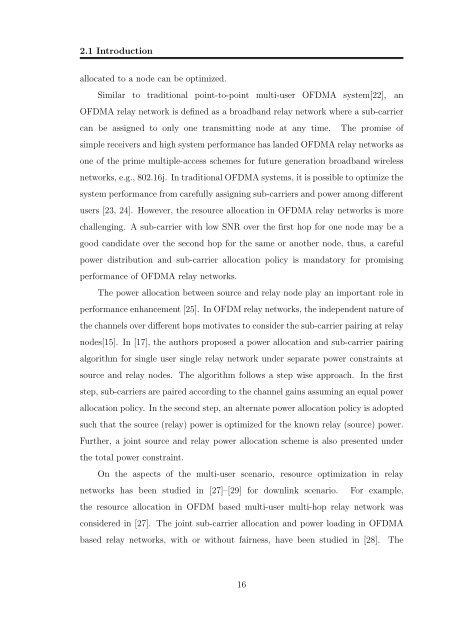Resource Allocation in OFDM Based Wireless Relay Networks ...
Resource Allocation in OFDM Based Wireless Relay Networks ...
Resource Allocation in OFDM Based Wireless Relay Networks ...
Create successful ePaper yourself
Turn your PDF publications into a flip-book with our unique Google optimized e-Paper software.
2.1 Introduction<br />
allocated to a node can be optimized.<br />
Similar to traditional po<strong>in</strong>t-to-po<strong>in</strong>t multi-user <strong>OFDM</strong>A system[22], an<br />
<strong>OFDM</strong>A relay network is def<strong>in</strong>ed as a broadband relay network where a sub-carrier<br />
can be assigned to only one transmitt<strong>in</strong>g node at any time. The promise of<br />
simple receivers and high system performance has landed <strong>OFDM</strong>A relay networks as<br />
one of the prime multiple-access schemes for future generation broadband wireless<br />
networks, e.g., 802.16j. In traditional <strong>OFDM</strong>A systems, it is possible to optimize the<br />
system performance from carefully assign<strong>in</strong>g sub-carriers and power among different<br />
users [23, 24]. However, the resource allocation <strong>in</strong> <strong>OFDM</strong>A relay networks is more<br />
challeng<strong>in</strong>g. A sub-carrier with low SNR over the first hop for one node may be a<br />
good candidate over the second hop for the same or another node, thus, a careful<br />
power distribution and sub-carrier allocation policy is mandatory for promis<strong>in</strong>g<br />
performance of <strong>OFDM</strong>A relay networks.<br />
The power allocation between source and relay node play an important role <strong>in</strong><br />
performance enhancement [25]. In <strong>OFDM</strong> relay networks, the <strong>in</strong>dependent nature of<br />
the channels over different hops motivates to consider the sub-carrier pair<strong>in</strong>g at relay<br />
nodes[15]. In [17], the authors proposed a power allocation and sub-carrier pair<strong>in</strong>g<br />
algorithm for s<strong>in</strong>gle user s<strong>in</strong>gle relay network under separate power constra<strong>in</strong>ts at<br />
source and relay nodes. The algorithm follows a step wise approach. In the first<br />
step, sub-carriers are paired accord<strong>in</strong>g to the channel ga<strong>in</strong>s assum<strong>in</strong>g an equal power<br />
allocation policy. In the second step, an alternate power allocation policy is adopted<br />
such that the source (relay) power is optimized for the known relay (source) power.<br />
Further, a jo<strong>in</strong>t source and relay power allocation scheme is also presented under<br />
the total power constra<strong>in</strong>t.<br />
On the aspects of the multi-user scenario, resource optimization <strong>in</strong> relay<br />
networks has been studied <strong>in</strong> [27]–[29] for downl<strong>in</strong>k scenario. For example,<br />
the resource allocation <strong>in</strong> <strong>OFDM</strong> based multi-user multi-hop relay network was<br />
considered <strong>in</strong> [27]. The jo<strong>in</strong>t sub-carrier allocation and power load<strong>in</strong>g <strong>in</strong> <strong>OFDM</strong>A<br />
based relay networks, with or without fairness, have been studied <strong>in</strong> [28]. The<br />
16

















